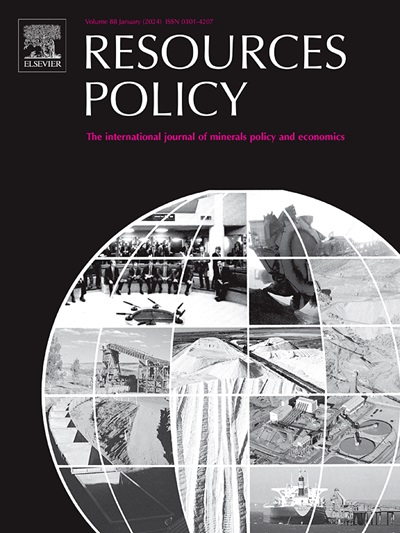基于多元回归(MVR)的未来矿产供应情景建模采矿项目成本估算
IF 10.2
2区 经济学
0 ENVIRONMENTAL STUDIES
引用次数: 0
摘要
对各种通讯、运输和能源技术日益增长的需求将需要各种各样的矿物,其数量将大大超过历史水平。为了模拟未来的矿产供应以满足这一需求,我们开发了一个新的、具有全球代表性的、基于多元回归(MVR)的采矿项目成本模型,该模型可用于估计农业、能源、基础设施和制造业等28种矿产商品的资本支出(CAPEX)和运营支出(OPEX)。这些公式利用常见的采矿项目参数,不需要详细了解具体项目来估算成本。报告的资本支出和运营支出数据的不均匀分布导致了两组MVR方程的产生:对于具有大样本量的商品(例如,Au, Cu, Zn)的特定商品MVR方程,以及对于具有最小报告数据的商品(例如,Nb, Ta和V)的数据汇总的非特定商品方程。针对以下19种矿物开发了特定商品的CAPEX和/或OPEX方程:Ag、Au、Co、Cu、Fe、石墨、Li、镧系元素、Mo、Ni、Nb、Pb、磷酸盐、钾肥、Pt、Sn、U、W和Zn,大多数方程的收益率为R2 >; 0.7。使用数据汇总方法,开发了非商品特定回归来估计铝土矿,铌,钽,钛,金红石,锰,钯,钛,钒和锆项目成本。此外,我们通过结合净现值(NPV)估算的案例研究证明了我们的方程的多种效用,突出了(1)价格波动对化肥项目的影响,(2)铂族金属项目联合生产对增加项目附加值和可行性的依赖,以及(3)各种铜项目满足日益增长的全球需求的能力。本文章由计算机程序翻译,如有差异,请以英文原文为准。
Multivariate regression (MVR) mining project cost estimator for future mineral supply scenario modeling
Growing demand for various communication, transportation and energy technologies will require a wide range of minerals at quantities that are significantly greater than historical levels. To model future mineral supplies to meet this demand, we developed a new, globally representative, multivariate regression-based (MVR) mining project cost model that can be used to estimate capital expenditures (CAPEX) and operational expenses (OPEX) for 28 mineral commodities that cover the agricultural, energy, infrastructure, and manufacturing industries. These equations utilize common mining project parameters and do not require detailed knowledge of a specific project to estimate costs.
An uneven distribution in reported CAPEX and OPEX data led to the generation of two sets of MVR equations: commodity-specific MVR equations for commodities with a large sample size (e.g., Au, Cu, Zn), and data-aggregated, non-commodity-specific equations for commodities with minimal reported data (e.g., Nb, Ta, and V). Commodity-specific CAPEX and/or OPEX equations were developed for the following 19 minerals: Ag, Au, Co, Cu, Fe, graphite, Li, lanthanides, Mo, Ni, Nb, Pb, phosphate, potash, Pt, Sn, U, W, and Zn, with most equations yielding R2 > 0.7. Using the data aggregated approach, non-commodity-specific regressions were developed to estimate bauxite, Nb, Ta, ilmenite, rutile, Mn, Pd, Ti, V, and Zr project costs. Furthermore, we demonstrate the diverse utility of our equations through case studies coupled with Net Present Value (NPV) estimates, highlighting (1) the impact of price volatility on fertilizer projects, (2) the dependency of co-production in platinum group metal projects for increasing the added value and viability of the project, and (3) the capability of various copper projects in meeting growing global demand.
求助全文
通过发布文献求助,成功后即可免费获取论文全文。
去求助
来源期刊

Resources Policy
ENVIRONMENTAL STUDIES-
CiteScore
13.40
自引率
23.50%
发文量
602
审稿时长
69 days
期刊介绍:
Resources Policy is an international journal focused on the economics and policy aspects of mineral and fossil fuel extraction, production, and utilization. It targets individuals in academia, government, and industry. The journal seeks original research submissions analyzing public policy, economics, social science, geography, and finance in the fields of mining, non-fuel minerals, energy minerals, fossil fuels, and metals. Mineral economics topics covered include mineral market analysis, price analysis, project evaluation, mining and sustainable development, mineral resource rents, resource curse, mineral wealth and corruption, mineral taxation and regulation, strategic minerals and their supply, and the impact of mineral development on local communities and indigenous populations. The journal specifically excludes papers with agriculture, forestry, or fisheries as their primary focus.
 求助内容:
求助内容: 应助结果提醒方式:
应助结果提醒方式:


